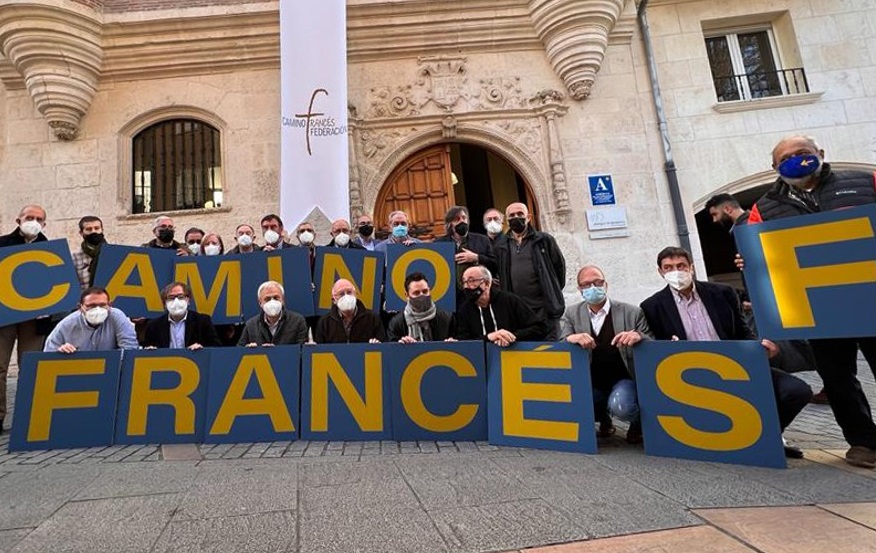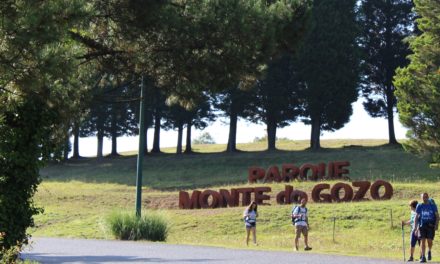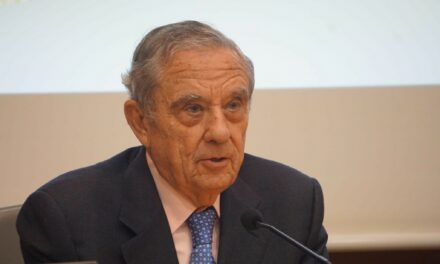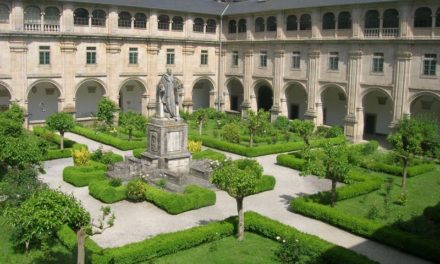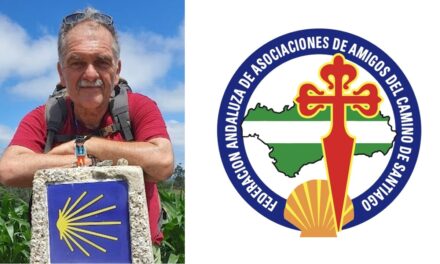Miguel Pérez Cabezas has just been appointed coordinator of the provisional board of directors of the French Way Federation, of which the Jacobean associations of Burgos, Logroño, Estella and Astorga are part, and will be until they ratify the positions at the next general assembly. This decision to establish a provisional directive makes clear the spirit of the new federation: they want to work for the French Way from the first moment of its inception and do it in a collegiate way.
Being a Founding member of the Association of Astorga, Señor Pérez Cabezas has worked and been present in all the important activities of the association, including the purchase and management of the hostel. He has also been the coordinator of the Association of Towns of the Vía de la Plata between 2000 and 2010, managing to place it as the second busiest road. Later he was, along with other colleagues from the associations of Astorga and Jaca, the promoter of the Association of Municipalities of the Camino de Santiago, which managed and manages to gather all the political forces in the country round the same table. The French Way Federation wishes to continue this work, because on the French Way, contrary to what is thought, “there are still too many pending issues to solve.”
‘The French Way Federation’ (CFF) has just been created, in a context full of associations and federations. I would like to know something about the specific characteristics of this new organization. The choice of the name, putting the French Way before the reference to the federation, already indicates that the central spot in the itinerary… Why a Federation for the French Way?
Because we are at a key moment where the survival of Camino de Santiago is at stake. The Camino is a unique phenomenon in the world that has its roots in a thousand-year-old history, but which is about to become a mere tourist attraction, thanks to a determined effort on the part of the institutions to achieve it. And we feel, in some way, that we are the custodians of a part of that 1,000-year legacy and therefore we bear the responsibility of trying to prevent this from happening. A Way that does not take into account its spiritual base, that does not take care of its essence and that does not fight for the survival of its values will have no future. It will cease to be a unique phenomenon.
On the other hand, with respect to the Camino Frances, it is important to start clarifying some of key issues. The first would be that, although all the roads to Santiago deserve the utmost respect, they are not all the same. Bear in mind that the Camino Frances is the only one that was expressly created as such. That is why, and correctly so, it is called with the “de” of Santiago. It is the only one where political, religious and social wills were united and that led to the founding of cities, the construction of bridges and relevant routes, or the making of express legislation to be able to make a pilgrimage to the ends of the world. The complete set, almost like a corpus of actions, of all these facts as such do not occur in any other way. It is a road created to unite Spain with Europe, which changes due to this, the existing commercial conception of crossing the peninsula from north to south and also from east to west, with the aim of uniting us again with the rest of the continent.
In addition, recently, it is the one that has been decorated with the maximum possible “medals” for its historical and heritage value: 1st European Itinerary, World Heritage Site and B.I.C. in all its layout. And these awards to a whole history, it should not be forgotten, are also responsibilities for the people who live on this route, obliged to comply with a protective legislation that is not found on other roads. As for the institutions – due to the legislation and prizes that have been awarded- they are obliged to respect it.
The French Way also has, after all these years, the greatest number of pilgrims in the world, far more than any other way. And this is so because it also has a unique infrastructure related to the so-called Traditional Reception. An activity as old as the road itself, carried out by hundreds of volunteers from all over the world, which has allowed us to become the first to recover after the closure of the country due to the pandemic. What is more it is the path that proposed and led a system of health protocols to open shelters, that promoted campaigns to recover the pilgrimage and that is helping to ‘deseasonalize’ the pilgrimage thanks to the fact that its shelters remain open throughout the winter.
And despite all this, the Camino Frances must face permanent negative publicity and a situation of percentage drop in pilgrims. In the last decade we have gone from representing +/- 85% of pilgrims in 2009, to 56% of pilgrims in 2019, a loss of almost 30%. We have some data of great interest from this loss: such as the fact that in the same time the Spanish roads as a whole have barely grown by 4% and the fundamental increase has occurred in the Portuguese roads with an increase of more than 25 %. We want the other Spanish roads to bear that in mind and realize that the better the Camino Frances is, the better it is for them. There should be no competition between the itineraries, they must complement each other and not lose the Jacobean essence. A positive experience of the Camino Frances for the majority of pilgrims, produces the desire to follow other paths, and that has always been the case.
Finally, there is the negative publicity that we have suffered in recent years, many times encouraged by ourselves, and at other times intentionally launched from abroad. As an example, some stereotypes that by dint of repeating them seem to have become a motto and are not true.
The first thing we want to deny is that it is NOT true that the Camino Frances is overcrowded with pilgrims. It is not overcrowded in any section of the road at any time of the year. If we remove weekend hikers or curious hikers who come to the path in some sections, the French Way is still a path with a lot of growth potential for pilgrims who can enjoy a unique experience. If we also think of areas such as the entrance through Aragón, where there are barely 2,000 pilgrims a year, it is difficult to think of overcrowding.
Another curious mantra is the jump of pilgrims in the area between Burgos and Palencia due to the difficulty of its stages in summer. Anyone who follows the guidelines suggested to the pilgrim knows perfectly well that providing he gets up early, by mid-morning he is usually already resting at the stopping place. It does not seem, therefore, that the excess of heat is enough to avoid those stages. Just as it is not the case that in the middle of winter, unless there is excessive snowfall, the Roncesvalles, Foncebadón or O Cebrerio mountain passes are blocked. We have realised, therefore, that in a certain way there is behind this a kind of hoax that we ourselves have come to believe and spread. That said, I think that no one should miss the plains of Burgos and Palencia on summer days, where they can contemplate the most extraordinary sunrises and sunsets that one can imagine. But it is also true that along the way, just as in life itself, we will find happy moments and difficult moments and this, together with overcoming them, is what makes it a unique life experience.
That is why CFF was born with the aim of defending the French Way. In the conviction that, if we are able to ensure that the Camino Frances maintains its values, our work will have repercussions on the rest of the routes. We are going to identify the problems and look for solutions, solutions which will help in finding answers or may even anticipate problems for other paths.
-Within the initial group of founding members of CFF there are present most of the large Associations of Friends of the Camino of this itinerary, but also the Brotherhood of Santo de Santo Domingo de la Calzada and a supra-national entity such as the International Fraternity of the Camino de Santiago … What kind of organizations is CFF open to?
To all those who, in a direct but also indirect way, work for the French Way. At this time all the associations of the French Way are present, but foreign associations that bring volunteers to the French Way and manage hostels and, in general, all those organizations that watch over the French Way in one way or another can also collaborate with us, with the understanding that not everyone will have the same role within our organization. The Associations of Friends of the Camino will be the backbone of the organization, with the maximum responsibilities, but together we will try to make room for other groups and organizations in one way or another to the extent that they act for the benefit of the Camino. The French Way, by its nature, cannot and will not be exclusive.
-Regarding the work of the CFF, firstly, I would like to ask you about the values and objectives with which it was created and which will determine your projects…
Values are intrinsic to the Camino and our duty is to promote and defend them. Regarding the objectives, we do have a series of basic and general objectives:
1/ Give a unique voice to the French Way, although we can include other voices in our contributions, we want ours to be strong, a reference and an authority for being fully integrated into the territory and in the daily life of the Way. Not in vain are we made up of some of the most important and historic organizations in the recent history of the Camino;
2/ Protect and defend the route, because unfortunately every year some section of it continues to disappear. Care for and protect it with zeal, being loyal to the institutions, but at the same time rigorous in denouncing excesses when necessary;
3/ Attend and protect the pilgrim through the Traditional Welcome. We want to be a model of how to care for and attend to pilgrim’s needs on the Camino de Santiago. In parallel, and as far as possible, with joint actions with other organizations of the path that have been doing it these years;
4/ Promote long-distance pilgrimage. We do not wish to devalue those who can only do a short walk, but we believe that the Camino is a vital experience and one that it is acquired over a long distance. The pilgrim who arrives in Compostela 30 days after setting out, perhaps suffering a bit but enjoying the landscape, the weather, the people of the towns through which he passes, the time spent with other pilgrims in the hostels, does not feel the same as someone who arrives after 100 kilometers and just 4 days travel. Taking care of the pilgrimage experience is a fundamental element for us;
5/ To be a reference point for the administrations. If we have experience, ideas, knowledge and also management, we cannot fail to be a point of reference for administrations. And that is how they should understand it.
-Based on the values and objectives that you have just mentioned, what projects or interventions have you already decided on? Are there specific actions that the CFF will launch soon?
There are already specific projects or measures, but fundamentally we will develop a work plan from the formation of the definitive Board of Directors that comes out of the General Assembly.
Yes, we are clear that we are going to work on the long-distance pilgrimage with the idea of rewarding or giving positive incentives to those who do it. Benefits that we want them to be able to obtain from associations, institutions, municipalities, the church, etc.
We are also clear that we want to protect a reception model and try to implement it in all the hostels on the French Way. At least in the hostels of the associations that are involved, forming thus a network of standard procedures.
We will also defend the essence of the path by generating a series of pilgrimage documents that allow those who read them to reflect on their singularities, understand them and, as far as possible, promote them.
We want to explain, and we are already doing so, to those responsible for tourism that the important thing is not to promote the Camino de Santiago as a commercial brand, but to identify it with its essence and present this as something to be protected, to the extent that it makes the Camino a unique experience in the world.
It is in the DNA of the Camino de Santiago to be the closest thing to responsible and sustainable tourism, in fact it already was before that model existed. But it is much more than that, it is a vital and spiritual experience and it is our obligation to protect and preserve it.
And we will also denounce, where necessary, the excesses that are causing the route of the Camino to be a Site of Cultural Interest that it is.
-What relationships do you envisage at the territorial level? I am referring to whom you would like to be your privileged collaborators, if you consider working with local, provincial, territorial administrations, at the CCAA level…
We want to work and interact with all administrations, from the local ones – which need informants who can talk to them about the reality of the Camino and tell them about how to proceed -, to the provincial ones – which tend to be the forgotten ones of the Camino despite being the ones that make the biggest investment of energy each year – going through regional administration and national administration. For us they are all important.
We know that each can play a role and be an important element in addressing and solving problems. For example, in the case of the central administration, each ministry has a role in the Camino: security, promotion, culture… They all have functions in it, but in most cases there is no coordination between them and investments are repeated every year. duplicated or misunderstood and important aspects are left unresolved. For years it has been demanded that the dangerous crossings on the Camino disappear and, today, they still exist in a very high number.
And, of course, we want to work a lot with the Spanish and foreign Jacobean associations.
-You have already talked about welcoming pilgrims as one of your objectives, could you tell us a little more about the role of hospitality in the CFF?
It’s fundamental. For us, the Camino stands on three legs: the associations, many of them with shelters; the work on the layout: signalling and care; and the welcome and attention to the pilgrim.
Our model is traditional reception, we are determined to take charge of its protection and implantation where possible – collaborating side by side with one of our partners: the F.I.C.S. that has become the standard-bearer for the protection and promotion of it. All this because we know that if the traditional welcome is lost, the pilgrims will disappear, and we will have something else, but not pilgrims.
It is not simply a matter of defending a model of reception for its tradition and history, it is that one of the most valued elements of the Way is based on it, which is its universality. The traditional welcome is what allows pilgrims from many countries of the world to do the Camino where purchasing power is not very great. The containment of expenses that allows the traditional, austere reception as exercised by volunteers, makes this possible. The operation is simple: each pilgrim who contributes an amount or leaves a donation, allows the shelter to be opened the next day for the other pilgrims. The scheme is completed by the participation of thousands of volunteers from around the world who help and collaborate in the management of these spaces. The scheme is an example of solidarity, collaboration and mutual aid, as well as an example of a circular economy.
On the other hand, traditional reception is an absolutely original phenomenon on a global level. This is another fundamental value of the Way that we have to defend.
If the model is lost, a fundamental part of the spirit of the Way will also be lost. Obviously, we know that it has to coexist with other initiatives, such as the private one, which must be respected and it is good that they exist. Other options are possible, but for us the backbone of the Camino is the traditional reception and it must be protected.
With respect to it, we want to create documents that give people an understanding of what it is, that clarify their concepts about it and that generate pride for having an ancestral initiative that after centuries has not been lost along the way. Protecting the Traditional Reception, then, is protecting the Way.
-Based on your meetings and work, could you make any comments on how you see the situation of the French Way in the face of this Holy Year 2022? And in the medium term, in the following years?
For us, the Holy Year 2022 is practically over from the point of view of splendour and celebrations, something that it has unfortunately become for the institutions. We are more concerned about the future of the Camino: if the ‘product’ is going to continue to be exploited, regardless of its background and what it means, if the pilgrims are going to be thought of, if the associations that have been looking after the Camino for years on their own and have a broad knowledge, will we have a voice when facing problems, etc.?
The Camino de Santiago is fortunate in having voluntary organizations that work all over the world so that people from all countries walk to the tomb of Santiago and this reality should not be modified or distorted. We want to help understand this type of thing, we want to collaborate so that this devirtualization does not occur and the pilgrims, as is now happening, will return to the Camino.
The creation of the CFF responds somewhat to all this. To the need to think about the Way in terms of the future, permanently looking at its past. And in that sense we are a unique example, some organizations created more than 30 years ago that, after years of strenuous efforts to remove the Way from ostracism, are once again at the forefront with the same enthusiasm as when they were created. In this situation, the French Way has no other choice but to have a future.

